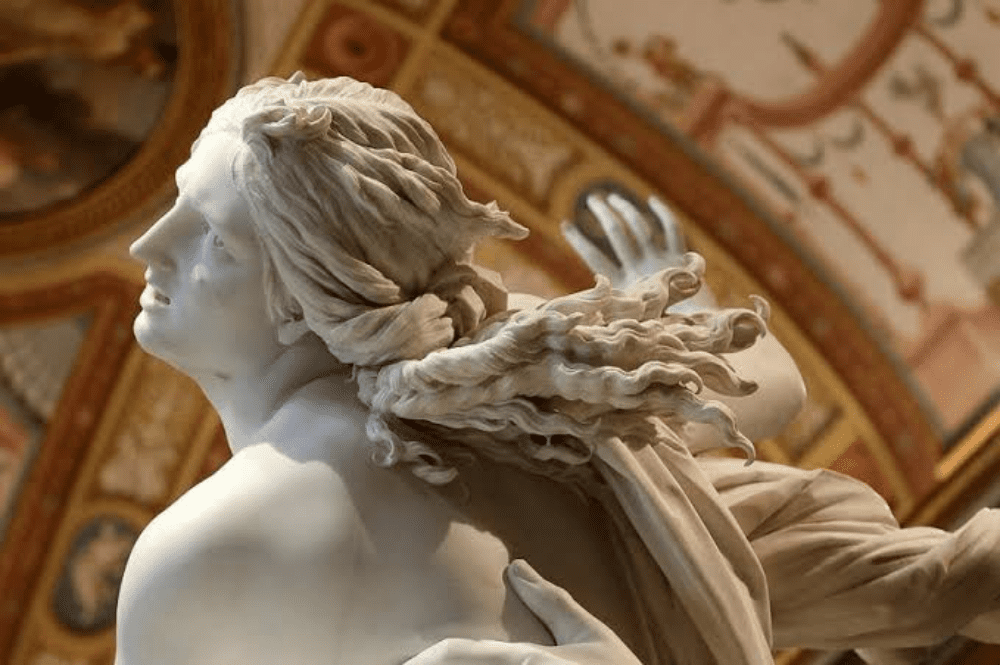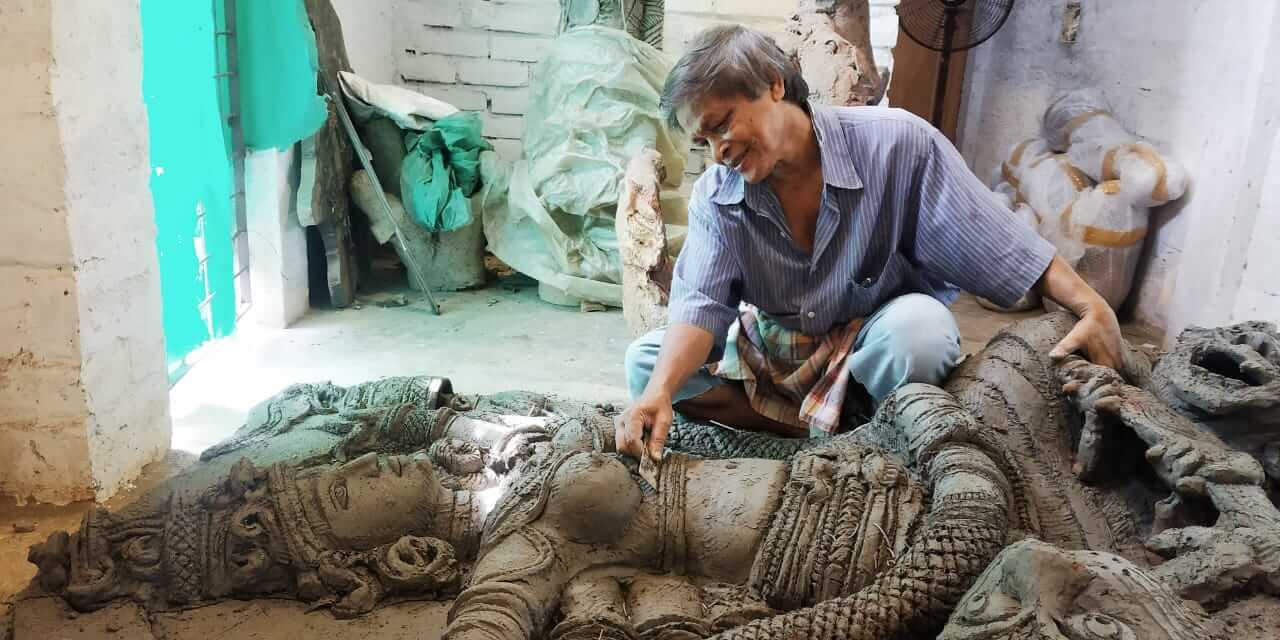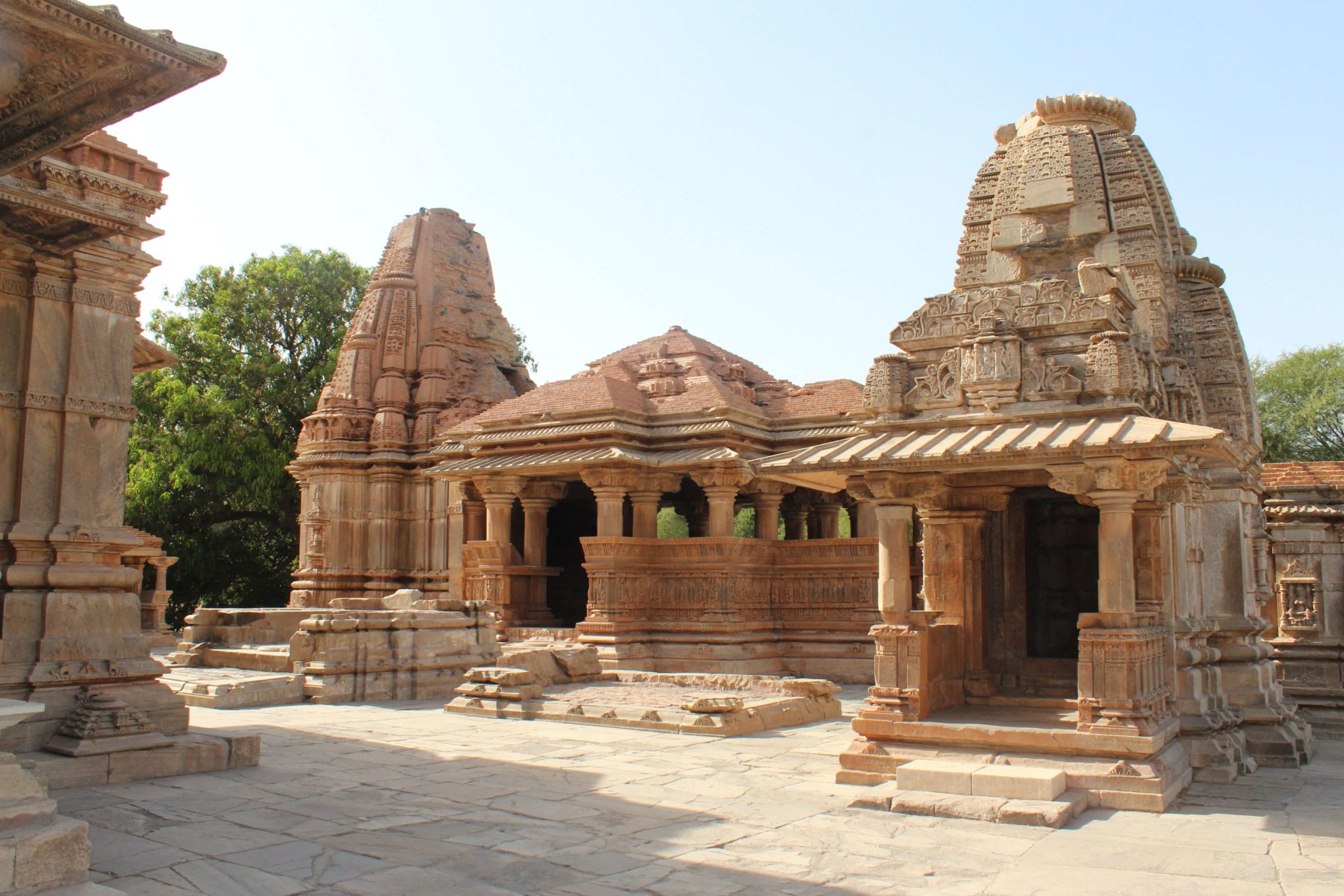Continuing with the exotic journey of ‘Lady Reims’, Monika discusses a few more intriguing relics and artifacts, in the third and final part of her research article on Notre Dame. An exclusive for Different Truths.
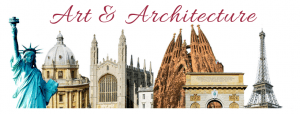 Let’s begin with the Iconic Tympanum, ‘The Last Judgement’.
Let’s begin with the Iconic Tympanum, ‘The Last Judgement’.
Notre-Dame’s western façade is a beauty, personification of extraordinary Gothic Architecture. A paragon of Antiquity. Approximately, 15 million tourists visit The Dame to admire the archetype, stone sculpture.
Western façade of the cathedral has three doors (portals), that rest between two 223 ft. obelisks, both of which were completed in the mid-13th century as per the cathedral. Above the three portals, spans a row of 28 statues representing 28 Kings of Judah.
Below the portals, is the main entrance to the church. The central portal represents the ‘Portal of Judgement’, built around 1230. It tells a saga of Jesus’ judgment from the Bible.
The judgment sequence is very intriguing. It shows Jesus in the center, with souls being granted (or denied) approach to Heaven beneath him.
The judgment sequence is very intriguing. It shows Jesus in the center, with souls 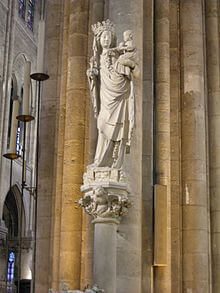 being granted (or denied) approach to Heaven beneath him. Many figures in the multileveled arch are depicted in gothic style. It has created an unearthly effect, portraying the holy people in Heaven hailing Jesus.
being granted (or denied) approach to Heaven beneath him. Many figures in the multileveled arch are depicted in gothic style. It has created an unearthly effect, portraying the holy people in Heaven hailing Jesus.
Completed in 1220, the left door represents the ‘Portal of the Virgin Mary’. It tells the story of Mary’s death and rises to heaven. To the right is the Portal of St. Anne, built around 1200, shows Mary with juvenile Jesus along with sculptures of King David, St. Peter and few more.
Under the guidance of Paris’ Bishop Eudes de Sully, it took almost a century to build ‘The West Façade’ of the cathedral.
The Rose Window
Rose windows, a masterpiece of Gothic architecture was introduced in Notre Dame de Reims in the mid-13th century. A kaleidoscopic arrangement of hundreds of stained-glass panes within carved stone trace work, extending out from a central image is breathtakingly astonishing.
The roses, which crown the north, south and west faces of the cathedral, have survived numerous ransacking, the French Revolution, two world wars, and a recent tragic fire.
The roses, which crown the north, south and west faces of the cathedral, have survived numerous ransacking, the French Revolution, two world wars, and a recent tragic fire. Placed just behind the grand organ, it was completely restored in the 19th century, retaining Middle-Ages’ original glass and tracery.
The west rose, the oldest one was one of the largest rose windows when created in 1225, though now the smallest of the three in Notre Dame. Its glass images are arranged into 15 “petals” that encircle an image of Mary holding the infant Jesus. The West Façade rose window is approx. 32 ft. in diameter. The halo forms a halo above the Virgin with Child statue is a treat to watch.
The north and south roses were built around 1250-1260 and face each other across the cathedral transepts.
The north and south roses were built around 1250-1260 and face each other across the cathedral transepts. Since 1730, the interior view of west rose was blocked by  the great organ. On the balustrade to the left and right of the rose window stand the statues of Adam and Eve which were added by Viollet-le-Duc.
the great organ. On the balustrade to the left and right of the rose window stand the statues of Adam and Eve which were added by Viollet-le-Duc.
Symbolically, each depiction or element of a Gothic cathedral has a meaning. The same goes for rose windows. The light straining through the stained glass is not merely decorative but depicts and elaborates a sense of the divine pouring in from above.
The rose window also conveys symbolic scenes from the Zodiacs and the Labours of the Months.
Gargoyles, the Keepers of the Dame
The Notre Dame is surrounded not by tens but hundreds of enigmatic and fascinating beasts, known as gargoyles. By definition, a gargoyle is a mythological sculpted or carved figure.
French legend from the Rouen area has a tale in which a creature like a dragon called ‘la Gargouille’ exists. It has a long neck, bat-like wings, has the ability to breathe fire and is ferocious.
The term is a French-originated from word ‘gargouille’, which means throat or gullet. This makes sense considering that water usually comes from a gargoyle’s 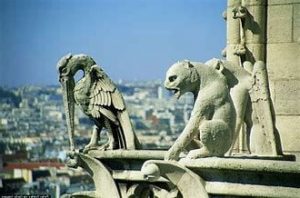 mouth. Also, another French legend from the Rouen area has a tale in which a creature like a dragon called ‘la Gargouille’ exists. It has a long neck, bat-like wings, has the ability to breathe fire and is ferocious.
mouth. Also, another French legend from the Rouen area has a tale in which a creature like a dragon called ‘la Gargouille’ exists. It has a long neck, bat-like wings, has the ability to breathe fire and is ferocious.
As the legend goes, St. Romanus conquered the Gargouille with his crucifix, and brought it back to Rouen to be burned but couldn’t tamper its head and neck with its own fire. Henceforth thereafter, so-called gargoyles were mounted on the walls of churches and cathedrals to keep away evil spirits. The very Gothic idea of doomed afterlife is suffering, and the gargoyles supposedly represent the evil outside versus the sanctity and safety of the church inside.
Along with the gargoyles few more mysterious beasts adorn Notre Dame cathedral including chimera, which are only ornamental only and serve no function.
Indeed, most of the gargoyles look ferocious, still few are decorous. Some even look weary. Along with the gargoyles few more mysterious beasts adorn Notre Dame cathedral including chimera, which are only ornamental only and serve no function. Wyvern, a pygmy 2-footed dragon, and the Styrga, also called “spitting gargoyle”. It was added along with many other chimeras as part of Viollet-le-Duc’s restoration and resembles a humongous bird with a large head, a voracious beak, wings, and horns.
Interestingly, it is said to eat human flesh, and reference to these creatures are found in works by the Roman poet Ovid and few artists like Charles Meyron.
While the true gargoyles whose main function was to drain the rainwater outside the cathedral were prone to erosion and moreover many other figures were removed or destroyed in the 17th and 18th centuries, particularly during the French Revolution.
Later, the French architect Eugène Emmanuel Viollet-le-Duc during his 25-year restoration of Notre Dame in the mid-1800s replaced them in Gothic style. Interestingly, he added a figure of himself as one of the new gargoyles.
Gargoyles are accompanied by various other intriguing figures on the cathedral including a Heron, with folded wings and a long beak facing downwards, sober-looking elephant and goats; a ferocious monkey, a wild boar, and a three-headed dog. Many eagles, a chimera eating grapes, and a demon gnawing on a human soul are few more attractions.
The ‘Mays’ of the Lady Reims and Other Paintings
Dating back to the 15th century, few renowned goldsmiths of Paris started gifting to Virgin Mary on every 1st May. In the mid-17th century, they switched to huge religious paintings to be displayed on the nave. Later many renowned artists competed for being chosen to paint for the “May”. The guidelines laid down by the Council of Trent were very stringent. Artists had to depict only religious stories and scenes of saints, gospels or apostles on huge walls in bright colours with no background components.
Soon after the French Revolution, the 76 ‘Mays’ were distributed. Only 45 were found later out of which 14 were found in Arras.
The famous ‘Mays’ became a huge platform for religious education. The custom had to be stopped by the start of the 18th century because there was no space for paintings on beams and nave. Soon after the French Revolution, the 76 ‘Mays’ were distributed. Only 45 were found later out of which 14 were found in Arras. Seven are presently showcased at Musée “Salle des Mays”.
Madonna and Child
Among the other priceless relics of the cathedral, the famous “Madonna and Child” remains one of the admired possessions. It’s approximately two metres statue, known as “Virgin of Paris”, created in the 14th century and depicts the Virgin Mary with the baby Jesus as the savior. It was moved to Notre-Dame in 1818.
This gorgeous piece of medieval Gothic architecture homes hundreds of priceless paintings and religious relics.
It is easy to comprehend why ‘The Lady’, a UNESCO world heritage site is the most visited place on earth. This gorgeous piece of medieval Gothic architecture homes hundreds of priceless paintings and religious relics. A monument with a rich history, beautiful art, and astonishing architecture.
The cathedral, which has survived almost 900 years of tumultuous French history of religious opposition, battles of power and politic and Nazi intentions and Revolution is currently closed as a result of the recent devastating inferno.
The Resilient Lady of Paris conquered the adversities each time. She shall overcome again.
References
1 Wikipedia – Notre Dame Paris
2. Wikipedia – Virgin of Paris
3. The Last Judgement Tympanum – msu.org
4. Mays – Notre Dame Paris – official site, Notre Dame.
5. Gargoyles- Medieval Life and Times.
Glossary
1.Tympanum: a vertical recessed triangular space forming the centre of a pediment, typically decorated.
2. Tracery: a delicate branching pattern ; ornamental stone openwork, typically in the upper part of a Gothic window.
3. Transepts: (in a cross-shaped church) either of the two parts forming the arms of the cross shape, projecting at right angles from the nave.
4. Nave: the central part of a church building, intended to accommodate most of the congregation. In traditional Western churches it is rectangular, separated from the chancel by a step or rail, and from adjacent aisles by pillars.
5. Balustrade: a railing supported by balusters, especially one forming an ornamental parapet to a balcony, bridge, or terrace.
6. Zodiac and The Labours of the Months: The term Labours of the Months refers to cycles in Medieval and early Renaissance art depicting in twelve scenes the rural activities that commonly took place in the months of the year. They are often linked to the signs of the Zodiac and are seen as humankind’s response to God’s ordering of the Universe.
7. Ovid: Roman poet who lived during the reign of Augustus. Born: 20 March 43 BC.
8. Charles Meyron: a French artist who worked almost entirely in etching, as he suffered from colour blindness.
(Concluded)
- Photos sourced by the author from the Internet

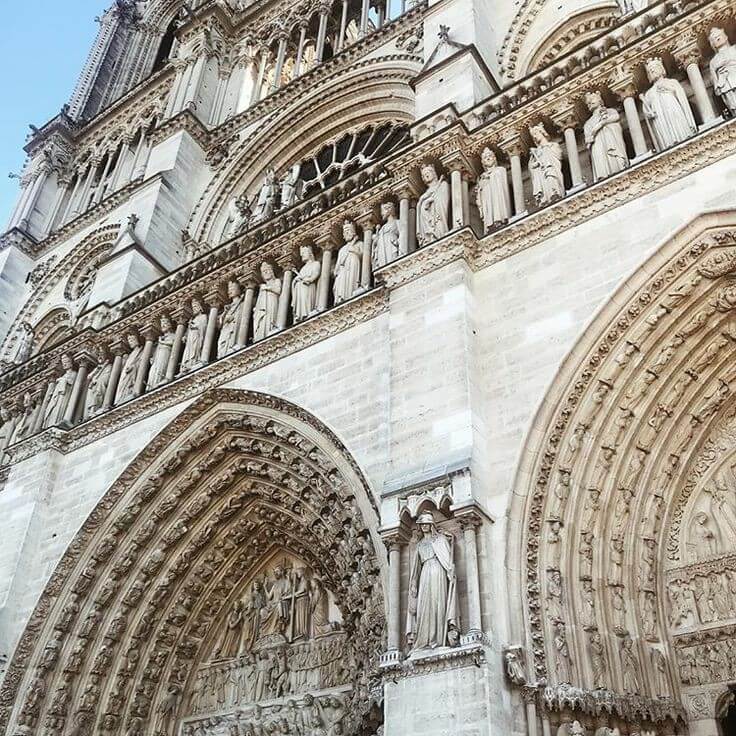
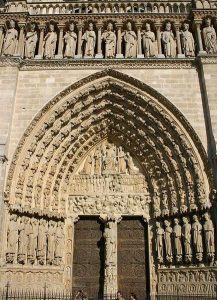



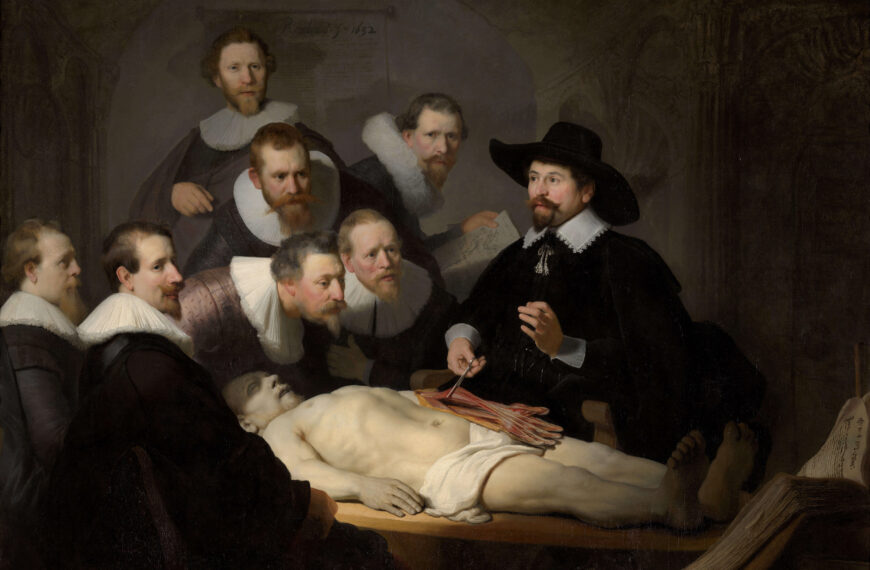
 By
By